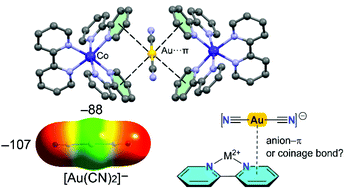On the nature of recurrent Au⋯π motifs in tris(2,2′-bipyridine)M(ii) (M = Fe, Co and Ni) dicyanoaurate(i) salts: X-ray analysis and theoretical rationalization†
Abstract
This manuscript reports the synthesis, X-ray characterization and DFT study of three new [M(bipy)3]2[Au(CN)2]3(X) (M = Fe, Co, and Ni; bipy = 2,2′-bipyridine; X = anion) ionic compounds. These salts are composed of [M(bipy)3]2+ dications and [Au(CN)2]− anions in a 2 : 3 ratio. The positive charge is compensated by X = Cl− anions in compounds 1 (M = Fe) and 2 (M = Co) and X = OH− in 3 (M = Ni). The three tridentate bipyridine ligands define the coordination of the M2+ cation, resulting in a nearly octahedral coordination sphere. The linear dicyanoaurate(I) anions are completely surrounded by a cradle of aromatic rings with Au-ring centroid distances below the sum of van der Waals radii, evidencing the existence of a specific Au⋯π attraction. This interaction has been analyzed in terms of the role of the Au-atom (Lewis acid or Lewis base) using DFT calculations combined with the quantum theory of atoms in molecules (QTAIM), noncovalent interaction plot index (NCIplot) and natural bond orbital (NBO) computational tools. The NBO suggests that the Au⋯π interaction is an example of a coinage bond in spite of the anionic nature of the acceptor and the cationic nature of the donor.



 Please wait while we load your content...
Please wait while we load your content...